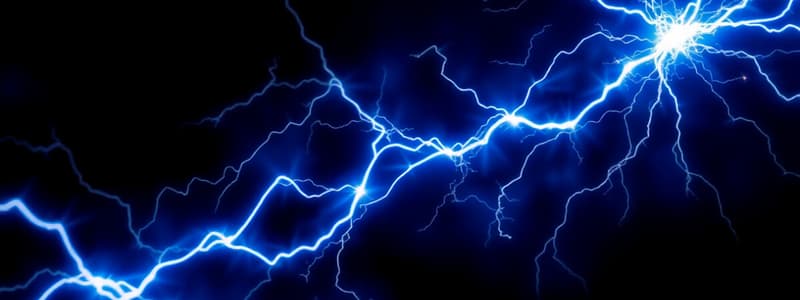Podcast
Questions and Answers
What is electric charge?
What is electric charge?
A fundamental property of matter that causes it to experience a force when placed in an electromagnetic field.
What are the types of electric charges?
What are the types of electric charges?
- Negative
- Neutral
- Positive
- Both A and B (correct)
Like charges attract each other.
Like charges attract each other.
False (B)
What is the value of the elementary charge?
What is the value of the elementary charge?
Which of the following materials is considered an insulator?
Which of the following materials is considered an insulator?
Define electric field.
Define electric field.
The formula for electric field strength (E) is E = _____ / q.
The formula for electric field strength (E) is E = _____ / q.
What does a denser field line indicate?
What does a denser field line indicate?
What is Coulomb's constant (k)?
What is Coulomb's constant (k)?
What does the Superposition Principle state?
What does the Superposition Principle state?
What is capacitance?
What is capacitance?
Study Notes
Electric Charge
-
Definition: A fundamental property of matter that causes it to experience a force when placed in an electromagnetic field.
-
Types of Charges:
- Positive (+)
- Negative (−)
- Like charges repel; unlike charges attract.
-
Quantization of Charge:
- Electric charge is quantized, meaning it exists in discrete amounts.
- Elementary charge (e) = 1.6 x 10⁻¹⁹ coulombs.
-
Conservation of Charge:
- Charge cannot be created or destroyed, only transferred.
-
Conductors and Insulators:
- Conductors allow charges to move (e.g., metals).
- Insulators do not allow charge movement (e.g., rubber, glass).
Electric Field
-
Definition: A region around a charged object where other charges experience a force.
-
Representation:
- Visualized using field lines:
- Lines direction indicates the force direction on a positive charge.
- Denser lines indicate stronger fields.
- Visualized using field lines:
-
Electric Field Strength (E):
- Defined as the force (F) per unit charge (q) exerted on a positive test charge.
- Formula: E = F/q
- Units: Newtons per Coulomb (N/C).
-
Source of Electric Fields:
- Due to point charges and distributions of charges.
- Positive charge creates outward field lines; negative charge creates inward.
-
Field of a Point Charge:
- Formula: E = k * |q|/r²
- k = Coulomb's constant (8.99 x 10⁹ N m²/C²)
- q = charge, r = distance from the charge.
- Formula: E = k * |q|/r²
-
Superposition Principle:
- The net electric field from multiple charges is the vector sum of the fields due to each charge.
Applications
- Capacitance: The ability of a system to store electric charge.
- Electric Circuits: Electric fields drive the movement of charges through conductors, powering devices.
- Electromagnetic Applications: Understanding electric fields is crucial in wireless technologies, motors, and generators.
Electric Charge
- A fundamental property of matter responsible for electromagnetic forces.
- Exists in two types: positive and negative.
- Like charges repel, unlike charges attract.
- Electric charge is quantized, meaning it exists in discrete units.
- The smallest unit of charge is the elementary charge (e), with a value of 1.6 x 10⁻¹⁹ coulombs.
- The principle of conservation of charge states that charge cannot be created or destroyed, only transferred.
- Conductors allow the free movement of charges, while insulators restrict charge flow.
Electric Field
- A region around a charged object where other charges experience a force.
- Represented using field lines that point in the direction of the force on a positive charge.
- The density of field lines indicates the strength of the electric field.
- Electric field strength (E) is calculated as the force per unit charge exerted on a positive test charge.
- The formula for electric field strength is E = F/q, with units of Newtons per Coulomb (N/C).
- Electric fields are generated by point charges and distributions of charges.
- A positive charge produces outward field lines, while a negative charge creates inward field lines.
- The electric field of a point charge is calculated using the formula E = k * |q|/r², where k is Coulomb's constant (8.99 x 10⁹ N m²/C²), q is the charge, and r is the distance from the charge.
- The superposition principle states that the net electric field from multiple charges is the vector sum of the fields due to each charge.
Applications
- Capacitance is the ability of a system to store electric charge.
- Electric circuits use electric fields to drive the movement of charges through conductors, powering various devices.
- Understanding electric fields is crucial in a wide range of electromagnetic applications, including wireless technologies, motors, and generators.
Studying That Suits You
Use AI to generate personalized quizzes and flashcards to suit your learning preferences.
Description
This quiz covers the fundamental concepts of electric charge and electric fields. Explore the definitions, types of charges, and the principles of conservation and quantization of electric charge. Additionally, learn about the characteristics of conductors and insulators, as well as the representation of electric fields.




